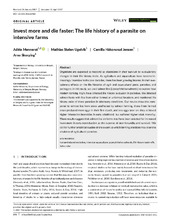Invest more and die faster: The life history of a parasite on intensive farms
Peer reviewed, Journal article
Published version

Åpne
Permanent lenke
https://hdl.handle.net/1956/18053Utgivelsesdato
2017-10Metadata
Vis full innførselSamlinger
Originalversjon
https://doi.org/10.1111/eva.12488Sammendrag
Organisms are expected to respond to alterations in their survival by evolutionary changes in their life history traits. As agriculture and aquaculture have become increasingly intensive in the past decades, there has been growing interest in their evolutionary effects on the life histories of agri‐ and aquacultural pests, parasites, and pathogens. In this study, we used salmon lice (Lepeophtheirus salmonis) to explore how modern farming might have affected life history evolution in parasites. We infected salmon hosts with lice from either farmed or unfarmed locations, and monitored life history traits of those parasites in laboratory conditions. Our results show that compared to salmon lice from areas unaffected by salmon farming, those from farmed areas produced more eggs in their first clutch, and less eggs later on; they achieved higher infestation intensities in early adulthood, but suffered higher adult mortality. These results suggest that salmon lice on farms may have been selected for increased investment in early reproduction, at the expense of later fecundity and survival. This call for further empirical studies of the extent to which farming practices may alter the virulence of agricultural parasites.
